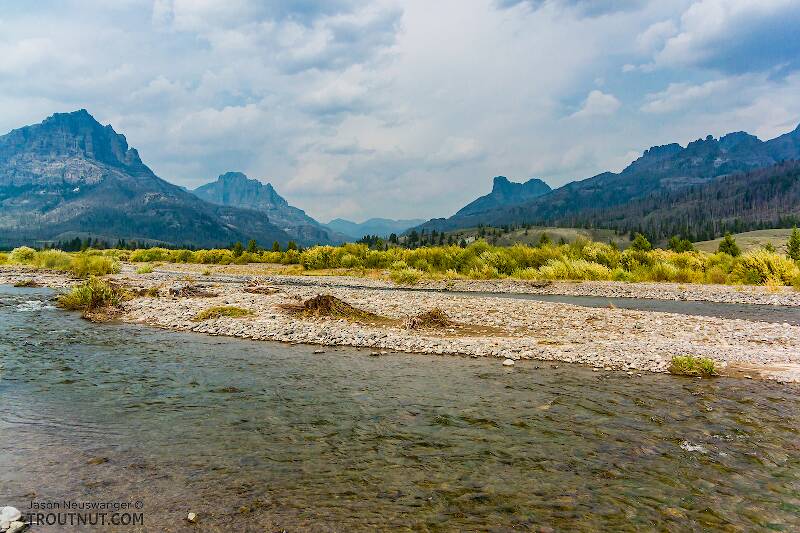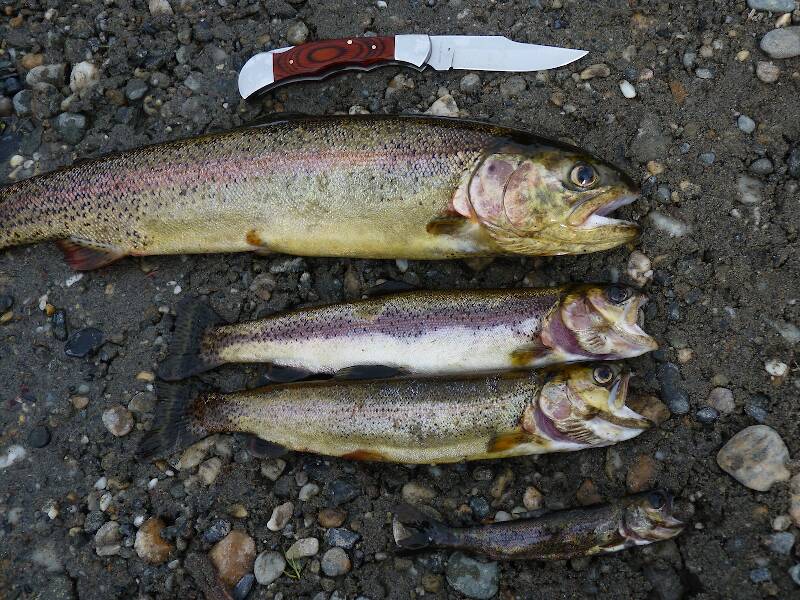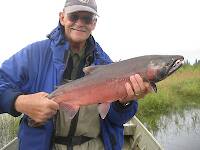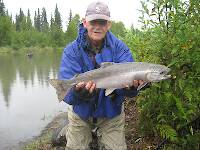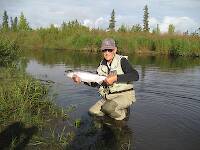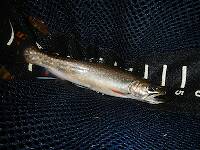
Salmonflies
Pteronarcys californica
The giant Salmonflies of the Western mountains are legendary for their proclivity to elicit consistent dry-fly action and ferocious strikes.
Featured on the forum

I caught this tiny larva without a case, but it seems to key pretty clearly to to Glossosomatidae. From there, the lack of sclerites on the mesonotum points to either Glossosoma or Anagapetus. Although it's difficult to see in a 2D image from the microscope, it's pretty clear in the live 3D view that the pronotum is only excised about 1/3 of its length to accommodate the forecoxa, not 2/3, which points to Glossosoma at Couplet 5 of the Key to Genera of Glossosomatidae Larvae.

Troutnut is a project started in 2003 by salmonid ecologist Jason "Troutnut" Neuswanger to help anglers and
fly tyers unabashedly embrace the entomological side of the sport. Learn more about Troutnut or
support the project for an enhanced experience here.
By Troutnut on August 11th, 2011
One of the perks of being an Alaska resident is that we can partake in several "personal use" fisheries that allow dip-netting for salmon. With harvest limits of up to 40 fish, they make it possible to have salmon as a staple of our diets, which we could never do by sport angling because of the 3-fish possession limit and the 10-hour round trip drive required to reach a decent salmon stream from Fairbanks. The crown jewel of Alaska's dipnetting sites is the sockeye salmon fishery at in the Copper River at Chitina. The salmon passing through here are very possibly the best-tasting fish in the world. Fed on plankton in the clean waters of Prince William Sound and the Gulf of Alaska, they stockpile unusually large amounts of tasty, healthy fatty acids in their firm, red flesh. The longer a salmon has to travel to reach its spawning grounds, the more fat it stores, so the tastiest salmon are those caught near the beginning of a journey up a very long river like the Copper or the Yukon.
Although "sporting" is the wrong word for dip-netting, it's much more challenging than most would expect. When I first heard about it, I pictured relaxed Alaskans standing on the bank of a clear, mid-sized river, nets laying on the ground as they watch and wait for salmon to appear. I had not imagined the thundering slurry of powdered mountain that is the Copper River at Chitina, a river the size of the Missouri squeezing through a bedrock canyon 100 meters wide. Most of the water is glacial melt, no clearer than chocolate milk, so densely is it loaded with the dust of the Alaska Range and the Wrangell Mountains. There's no outward sign of the thousands--sometimes tens of thousands--of salmon that pass through every day of the summer, inches below the opaque surface. The dip-netter perches on a narrow shelf of jagged rocks, holding a large net in the river continuously, fighting the force of the silt-laden current from the other end of a 15-foot metal pole. The telltale bump of a salmon in the net may come every few minutes, or hours apart, and I have spent about 12 hours on the net each year to obtain my limit. It's hard work to fill the freezer with this world-class delicacy.
Catch & release purists need not cringe at the sight of these photos: the Copper River sockeye salmon fishery is a sustainably managed, hatchery-supplemented fishery with limits and closures adjusted several times throughout the season by the Alaska Department of Fish & Game. The run each year contains more than enough salmon to replenish the population, especially with the hatchery's help, and the excess is split among commercial fishermen in Prince William Sound, native subsistence users who can each catch hundreds of salmon in their fish wheels, dip-netters in the "personal use" fishery, and a comparatively tiny harvest by sport anglers in clearer tributaries, mostly the Gulkana and Klutina rivers. Many of the fish we dipnet in the main stem Copper are destined for off-road tributaries that rarely see an angler, especially not a salmon angler. When someone fishes that far out into this part of the wilderness, they're in pursuit of grayling, dollies, or rainbows, not salmon.
Although "sporting" is the wrong word for dip-netting, it's much more challenging than most would expect. When I first heard about it, I pictured relaxed Alaskans standing on the bank of a clear, mid-sized river, nets laying on the ground as they watch and wait for salmon to appear. I had not imagined the thundering slurry of powdered mountain that is the Copper River at Chitina, a river the size of the Missouri squeezing through a bedrock canyon 100 meters wide. Most of the water is glacial melt, no clearer than chocolate milk, so densely is it loaded with the dust of the Alaska Range and the Wrangell Mountains. There's no outward sign of the thousands--sometimes tens of thousands--of salmon that pass through every day of the summer, inches below the opaque surface. The dip-netter perches on a narrow shelf of jagged rocks, holding a large net in the river continuously, fighting the force of the silt-laden current from the other end of a 15-foot metal pole. The telltale bump of a salmon in the net may come every few minutes, or hours apart, and I have spent about 12 hours on the net each year to obtain my limit. It's hard work to fill the freezer with this world-class delicacy.
Catch & release purists need not cringe at the sight of these photos: the Copper River sockeye salmon fishery is a sustainably managed, hatchery-supplemented fishery with limits and closures adjusted several times throughout the season by the Alaska Department of Fish & Game. The run each year contains more than enough salmon to replenish the population, especially with the hatchery's help, and the excess is split among commercial fishermen in Prince William Sound, native subsistence users who can each catch hundreds of salmon in their fish wheels, dip-netters in the "personal use" fishery, and a comparatively tiny harvest by sport anglers in clearer tributaries, mostly the Gulkana and Klutina rivers. Many of the fish we dipnet in the main stem Copper are destined for off-road tributaries that rarely see an angler, especially not a salmon angler. When someone fishes that far out into this part of the wilderness, they're in pursuit of grayling, dollies, or rainbows, not salmon.
Photos by Troutnut from the Copper River in Alaska
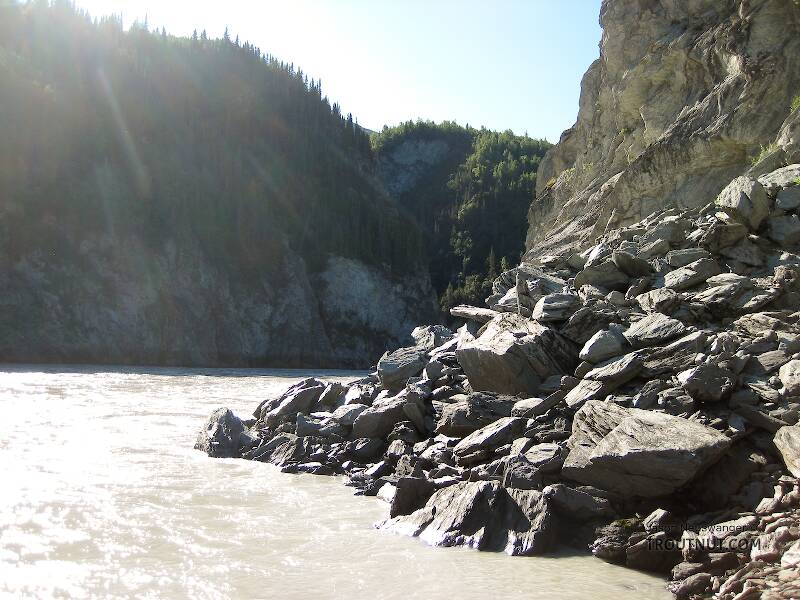
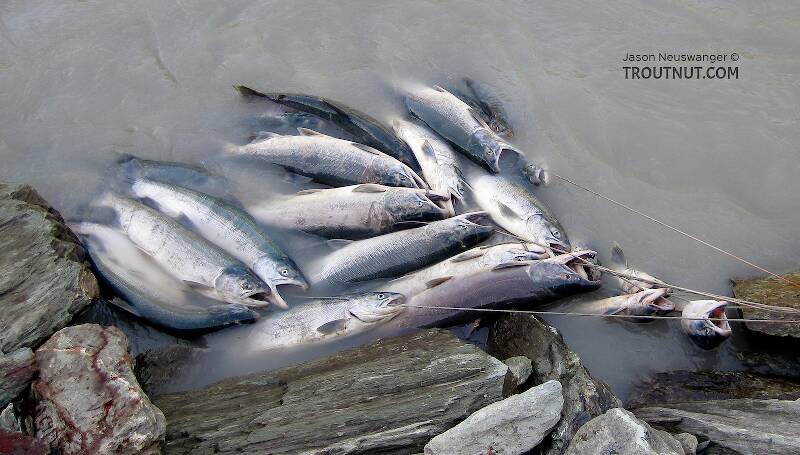
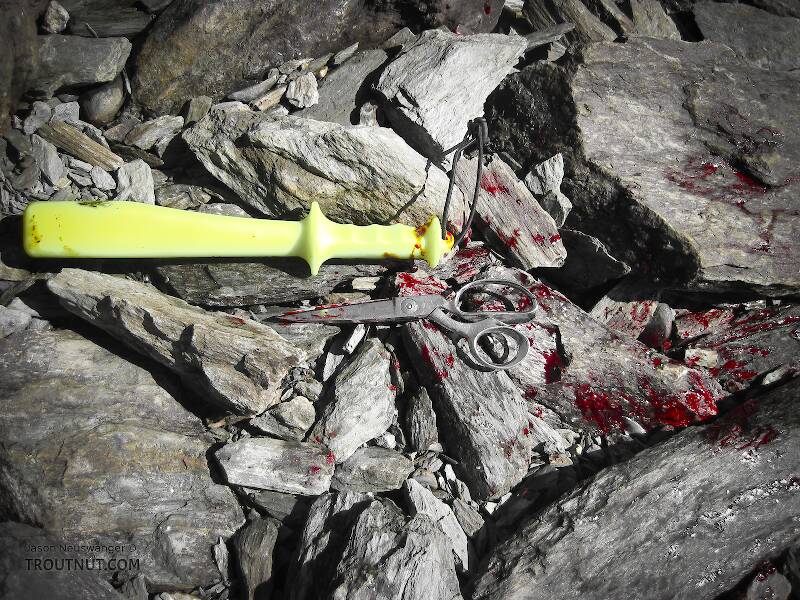
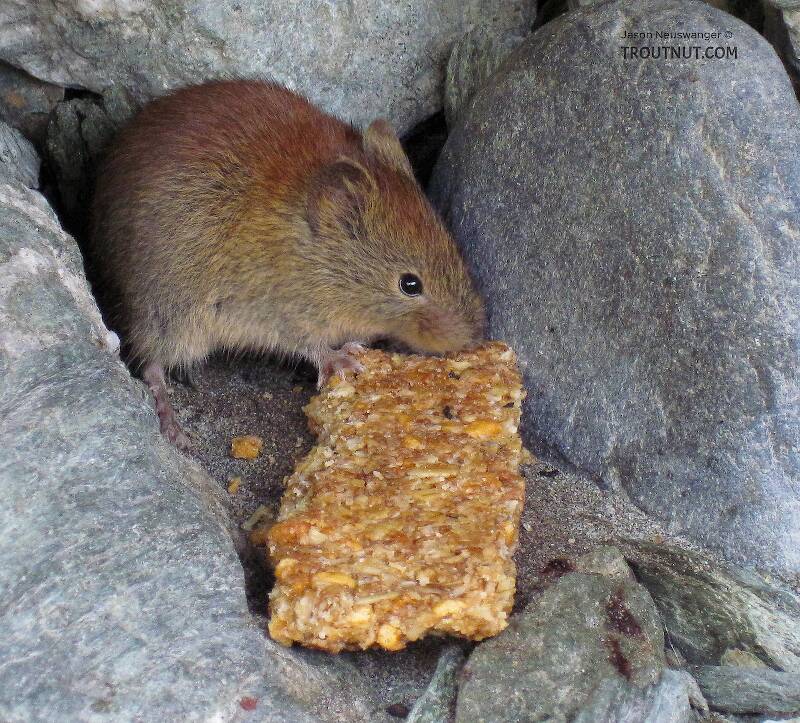
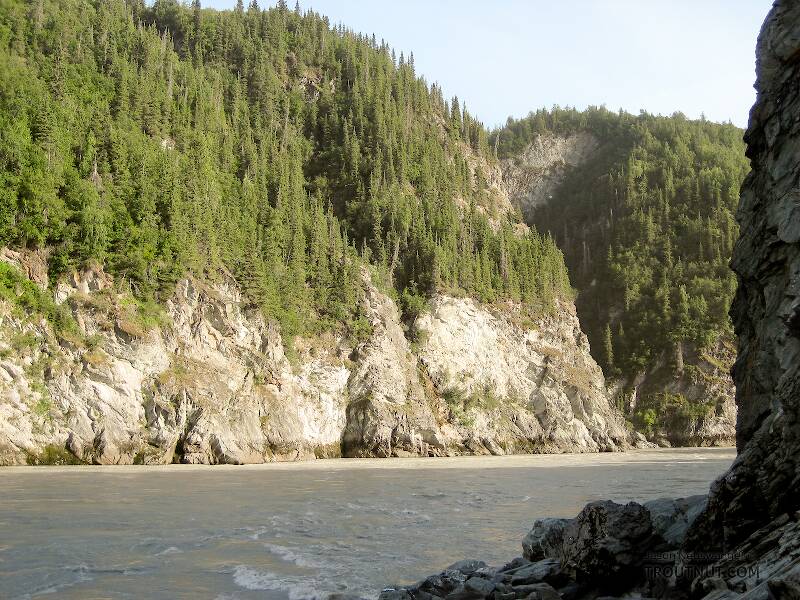
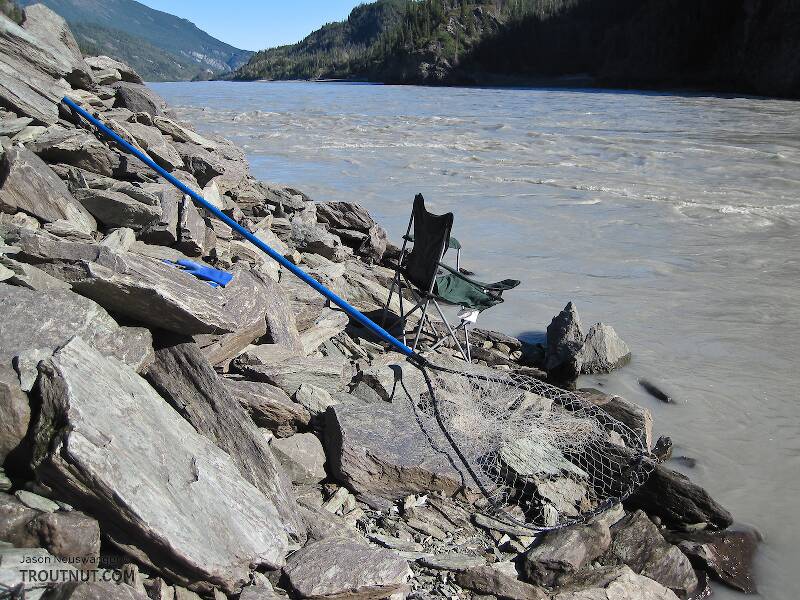
Closeup insects by Bnewell from the Touchet River in Washington
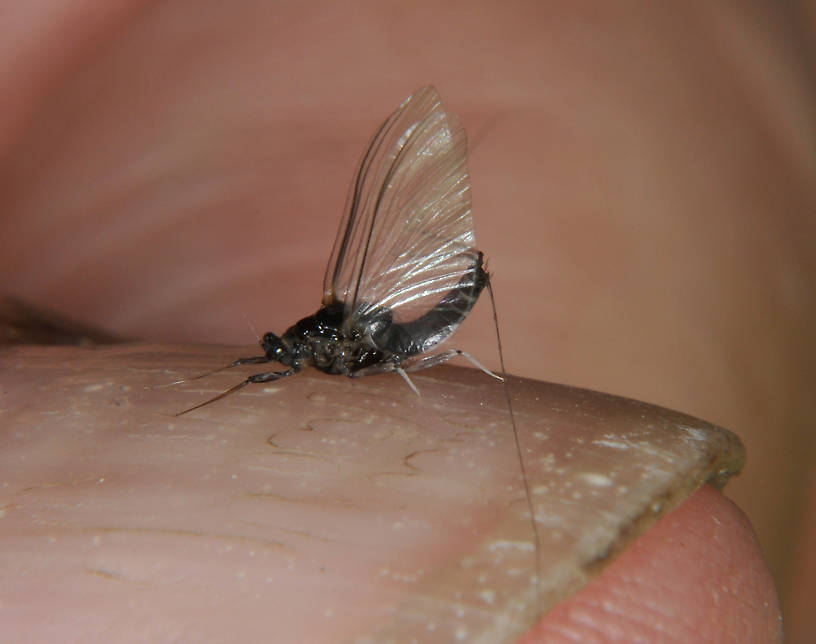
I collected these males about 9:30 AM, air temp. about 68 degrees F. The males were flying about 3 ft above the stream flying up and down the stream rather than the typical vertical swarm you see with most mayfly males. The males are black and the females are a green color due to the eggs they are carrying. They do not live very long which is typical for small bodied mayflies. They do not fly during windy conditions. I suspect these are Tricorythodes minutus.
Comments / replies
Troutnut on Aug 16, 2011August 16th, 2011, 2:50 pm EDT
I just added to this day's update, so I'm bumping its discussion.
Jason Neuswanger, Ph.D.
Troutnut and salmonid ecologist
Troutnut and salmonid ecologist
Oldredbarn on Sep 1, 2011September 1st, 2011, 8:30 am EDT
Jason,
Just to let you know you did not offend your vegetarian, catch-and-release buddy down in Detroit, I couldn't help but think what wonderful dubbing I could have made from that little "vole"...March Brown bodies...maybe Henny's...Hmmm. What a useful shade he/she is! ;)
Spence
Just to let you know you did not offend your vegetarian, catch-and-release buddy down in Detroit, I couldn't help but think what wonderful dubbing I could have made from that little "vole"...March Brown bodies...maybe Henny's...Hmmm. What a useful shade he/she is! ;)
Spence
"Even when my best efforts fail it's a satisfying challenge, and that, after all, is the essence of fly fishing." -Chauncy Lively
"Envy not the man who lives beside the river, but the man the river flows through." Joseph T Heywood
"Envy not the man who lives beside the river, but the man the river flows through." Joseph T Heywood
SalchaPat
Posts: 1
Posts: 1
SalchaPat on Jun 2, 2013June 2nd, 2013, 2:03 pm EDT
Hooks & Bullets just made some videos that show newbies how to dip net down in Chitina. Might be good for your forum. There's four of them I think on the Chitina page: http://www.adfg.alaska.gov/index.cfm?adfg=PersonalUsebyAreaInteriorChitina.video
GldstrmSam on Jun 3, 2013June 3rd, 2013, 11:14 pm EDT
I couldn't help but think what wonderful dubbing I could have made from that little "vole"
Hey Spence, I've actually tried to skin a vole for dubbing...I used a scalpel to do it and it was still a REAL pain.(How stupid could someone be:) There has to be a smarter way to do it...:)
Can't believe this season has rolled around already! Can hardly wait!
Sam
There is no greater fan of fly fishing than the worm. ~Patrick F. McManus
Quick Reply
Related Discussions
Topic
Replies
Last Reply
2
Aug 23, 2011
by Shawnny3
by Shawnny3
16
Aug 19, 2018
by Troutnut
by Troutnut
8
Oct 21, 2017
by Partsman
by Partsman
1
Mar 31, 2008
by Lifeaquatic
by Lifeaquatic

